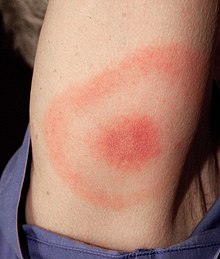Erythema: Difference between revisions
mNo edit summary |
specified exact etymology Tags: Mobile edit Mobile web edit |
||
| (3 intermediate revisions by 2 users not shown) | |||
| Line 1: | Line 1: | ||
{{Short description| |
{{Short description|Redness of the skin or mucous membranes}} |
||
{{Distinguish|arrhythmia|erythremia}} |
{{Distinguish|arrhythmia|erythremia}} |
||
{{More citations needed|date=December 2009}} |
{{More citations needed|date=December 2009}} |
||
| Line 26: | Line 26: | ||
}} |
}} |
||
'''Erythema''' ( |
'''Erythema''' ({{langx|grc|ἐρύθημα}}, {{ety|el|erythros|red}}) is redness of the skin or [[mucous membrane]]s, caused by [[hyperemia]] (increased blood flow) in superficial [[capillaries]].<ref>{{cite book |title=Mosby's Medical Dictionary |edition=9th |year=2013 |publisher=Elsevier |location=St. Louis, Missouri |isbn=978-0-323-08541-0}}</ref> It occurs with any skin injury, infection, or [[inflammation]]. Examples of erythema not associated with pathology include [[blushing|nervous blushes]].<ref>{{Cite encyclopedia |title=Erythema |encyclopedia=[[Mosby's Medical, Nursing & Allied Health Dictionary]] |edition=Fourth |publisher=Mosby-Year Book |year=1994 |page=570}}</ref> |
||
== Types == |
== Types == |
||
| Line 46: | Line 46: | ||
== Causes == |
== Causes == |
||
It can be caused by [[infection]], [[massage]], electrical treatment, [[acne]] medication, [[allergy|allergies]], exercise, solar radiation ([[sunburn]]), [[photosensitization]],<ref>{{citation | author1=Jane C. Quinn | author2=Yuchi Chen | author3=Belinda Hackney | author4=Muhammad Shoaib Tufail | author5=Leslie A. Weston | author6=Panayiotis Loukopoulos | title = Acute-Onset High-Morbidity Primary Photosensitisation in Sheep Associated with Consumption of the Casbah and Mauro Cultivars of the Pasture Legume Biserrula | journal = BMC Veterinary Research | year = 2018 | volume=14 | issue=1 | page=11 | doi= 10.1186/s12917-017-1318-7| pmid=29325550 | pmc=5765607 | doi-access=free }}</ref> [[acute radiation syndrome]], [[Mercury poisoning|mercury toxicity]], [[blister agent]]s,<ref>https://fas.org/nuke/guide/usa/doctrine/army/mmcch/Vesicant.htm#CLINICAL {{webarchive|url=https://web.archive.org/web/20171212112435/https://fas.org/nuke/guide/usa/doctrine/army/mmcch/Vesicant.htm |date=2017-12-12 }} EFFECTS</ref> [[Niacin (substance)|niacin]] administration,<ref>{{cite journal |vauthors=Weterle R, Rybakowski J |pmid=2084715 |title=Test niacynowy w schizofrenii |trans-title=The Niacin Test in Schizophrenia |language=Polish |journal=Psychiatr Pol. |date=Mar–Apr 1990 |volume=24 |issue=2 |pages=116–20}}</ref> or waxing and tweezing of the hairs—any of which can cause the capillaries to dilate, resulting in redness. Erythema is a common side effect of [[radiotherapy]] treatment due to patient exposure to [[ionizing radiation]]. |
It can be caused by [[infection]], [[massage]], electrical treatment, [[acne]] medication, [[allergy|allergies]], exercise, solar radiation ([[sunburn]]), [[photosensitization]],<ref>{{citation | author1=Jane C. Quinn | author2=Yuchi Chen | author3=Belinda Hackney | author4=Muhammad Shoaib Tufail | author5=Leslie A. Weston | author6=Panayiotis Loukopoulos | title = Acute-Onset High-Morbidity Primary Photosensitisation in Sheep Associated with Consumption of the Casbah and Mauro Cultivars of the Pasture Legume Biserrula | journal = BMC Veterinary Research | year = 2018 | volume=14 | issue=1 | page=11 | doi= 10.1186/s12917-017-1318-7| pmid=29325550 | pmc=5765607 | doi-access=free }}</ref> [[acute radiation syndrome]], [[Mercury poisoning|mercury toxicity]], [[blister agent]]s,<ref>[https://fas.org/nuke/guide/usa/doctrine/army/mmcch/Vesicant.htm#CLINICAL Vesicant] {{webarchive|url=https://web.archive.org/web/20171212112435/https://fas.org/nuke/guide/usa/doctrine/army/mmcch/Vesicant.htm | date=2017-12-12 }} EFFECTS</ref> [[Niacin (substance)|niacin]] administration,<ref>{{cite journal |vauthors=Weterle R, Rybakowski J |pmid=2084715 |title=Test niacynowy w schizofrenii |trans-title=The Niacin Test in Schizophrenia |language=Polish |journal=Psychiatr Pol. |date=Mar–Apr 1990 |volume=24 |issue=2 |pages=116–20}}</ref> or waxing and tweezing of the hairs—any of which can cause the affected capillaries to dilate, resulting in redness. Erythema is a common side effect of [[radiotherapy]] treatment due to patient exposure to [[ionizing radiation]]. |
||
== Diagnosis == |
== Diagnosis == |
||
Latest revision as of 02:43, 14 November 2024
This article needs additional citations for verification. (December 2009) |
| Erythema | |
|---|---|
 | |
| Characteristic "bull's eye" rash (erythema migrans) of early Lyme disease | |
| Specialty | Dermatology |
Erythema (Ancient Greek: ἐρύθημα, from Greek erythros 'red') is redness of the skin or mucous membranes, caused by hyperemia (increased blood flow) in superficial capillaries.[1] It occurs with any skin injury, infection, or inflammation. Examples of erythema not associated with pathology include nervous blushes.[2]
Types
[edit]Causes
[edit]It can be caused by infection, massage, electrical treatment, acne medication, allergies, exercise, solar radiation (sunburn), photosensitization,[3] acute radiation syndrome, mercury toxicity, blister agents,[4] niacin administration,[5] or waxing and tweezing of the hairs—any of which can cause the affected capillaries to dilate, resulting in redness. Erythema is a common side effect of radiotherapy treatment due to patient exposure to ionizing radiation.
Diagnosis
[edit]Erythema disappears on finger pressure (blanching), whereas purpura or bleeding in the skin and pigmentation do not. There is no temperature elevation, unless it is associated with the dilation of arteries in the deeper layer of the skin.[citation needed]
See also
[edit]References
[edit]- ^ Mosby's Medical Dictionary (9th ed.). St. Louis, Missouri: Elsevier. 2013. ISBN 978-0-323-08541-0.
- ^ "Erythema". Mosby's Medical, Nursing & Allied Health Dictionary (Fourth ed.). Mosby-Year Book. 1994. p. 570.
- ^ Jane C. Quinn; Yuchi Chen; Belinda Hackney; Muhammad Shoaib Tufail; Leslie A. Weston; Panayiotis Loukopoulos (2018), "Acute-Onset High-Morbidity Primary Photosensitisation in Sheep Associated with Consumption of the Casbah and Mauro Cultivars of the Pasture Legume Biserrula", BMC Veterinary Research, 14 (1): 11, doi:10.1186/s12917-017-1318-7, PMC 5765607, PMID 29325550
- ^ Vesicant Archived 2017-12-12 at the Wayback Machine EFFECTS
- ^ Weterle R, Rybakowski J (Mar–Apr 1990). "Test niacynowy w schizofrenii" [The Niacin Test in Schizophrenia]. Psychiatr Pol. (in Polish). 24 (2): 116–20. PMID 2084715.
